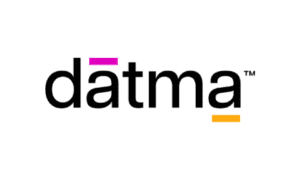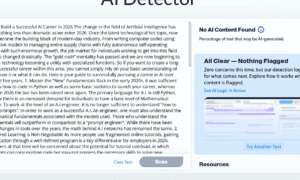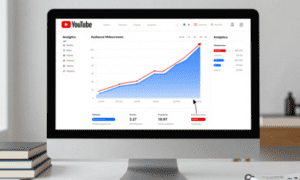In a world where time is money and every delay can cost organizations millions, the difference between project success and failure often hinges on one crucial factor, planning. Yet, as anyone who has worked on large-scale projects knows, even the most meticulous plans often unravel when confronted with reality. Deadlines slip, budgets bloat, and resources are stretched too thin.
But now, thanks to a groundbreaking piece of scholarship co-authored by Erica, the rules of the game are changing. Her work, published in the International Journal of Multidisciplinary Research and Growth Evaluation, demonstrates how predictive analytics, the same technology that powers modern financial forecasts and medical diagnostics, can be harnessed to revolutionize project planning.
This isn’t just an academic exercise. Erica’s research is already reshaping how organizations deploy their teams, allocate their budgets, and keep promises to stakeholders. It’s an advance that could save industries billions in wasted effort, while giving managers something they’ve long dreamed of foresight.

The Problem: Why Traditional Planning Falls Short
For decades, project planning has leaned heavily on charts, estimates, and expert judgment. While tools like Gantt charts and PERT diagrams brought structure, they also carried one major flaw: they relied on static assumptions and subjective inputs. Human bias and rigid forecasting frequently meant plans didn’t account for unexpected variables, from supply chain delays to sudden staff shortages.
“Traditional models can’t keep up with the complexity of today’s projects,” Erica explains. “When teams are spread across countries, technologies evolve mid-project, and risks multiply, we need more than intuition. We need data that learns and adapts.”
And that’s precisely where her work comes in.
The Breakthrough: Predictive Analytics Meets Project Management
The study Erica co-authored outlines a new framework that integrates predictive analytics directly into project planning. By feeding machine learning models with historical project logs, resource metrics, and risk profiles, managers can forecast delays before they occur, identify bottlenecks before they choke productivity, and allocate resources with laser precision.
Imagine a model that can predict, with remarkable accuracy, that a software rollout will be delayed in certain regions because local teams will need longer training due to regulatory differences. Or a forecast that shows a construction project will face a materials bottleneck two months from now, allowing teams to reorder supplies before it’s too late.
“Instead of reacting to problems after they explode, predictive analytics gives managers the chance to act before they even arise,” Erica notes.
Real-World Results: From Healthcare to Highways
The study didn’t stop at theory; it documented real-world case studies where predictive analytics has already been applied.
In one instance, a healthcare technology firm deploying software across multiple countries found its traditional estimates wildly inaccurate. By applying predictive models, the team improved task estimation accuracy by 38% and finished 15% ahead of schedule. This wasn’t just an efficiency boost, it meant life-saving diagnostic tools reached hospitals faster.
In another case, a government infrastructure project used predictive analytics to plan the rollout of smart transportation systems across an entire city. The result? Estimation accuracy improved by 42%, resource waste dropped by a third, and the project came in under budget, almost unheard of in infrastructure development.
“These are not abstract numbers,” Erica emphasizes. “They represent real projects, real money saved, and real people whose lives are improved when systems work the way they should.”
Erica’s Role: Championing Scope Clarity and Early Risk Detection
Among the many contributions in the paper, Erica’s focus on scope clarity stands out. Projects often fail not because of technical flaws, but because their goals are poorly defined. Ambiguities in task descriptions or underestimated workloads snowball into massive problems.
By applying pattern recognition and anomaly detection, Erica’s work enables project teams to catch these ambiguities early. A vague task description that might otherwise derail an entire workstream can be flagged for review before the project even begins.
“This part of the research is about protecting teams from preventable mistakes,” Erica says. “Clear scope and risk detection save countless hours of rework and frustration.”
Why It Matters: The Human Side of Predictive Planning
The impact of Erica’s scholarship goes beyond the balance sheet. While organizations gain efficiency, employees benefit too. Predictive models mean workloads are more evenly distributed, preventing burnout and ensuring resources aren’t wasted.
Stakeholders, too, gain trust in project outcomes. Instead of being blindsided by last-minute changes, they receive transparent, data-backed forecasts. In turn, this strengthens accountability and reduces the friction that so often plagues client-provider relationships.
And for global teams, many of whom collaborate remotely across time zones, the ability to see risks and dependencies before they turn into crises fosters cohesion and confidence.
The Bigger Picture: A New Era of Project Management
Erica and her co-authors are not just proposing a new planning tool, they are laying the foundation for a new era of project management. Their research frames predictive analytics not as a luxury, but as a necessity for the future.
As industries grapple with ever-growing complexity, from digital transformation to climate adaptation, the ability to foresee and mitigate risks will separate successful organizations from those that stumble. Predictive analytics transforms project management from reactive firefighting into proactive strategy.
“Data doesn’t replace human expertise,” Erica stresses. “It empowers it. Managers become strategists, not just schedulers. Teams gain foresight, not just hindsight.”
Looking Ahead: What Comes Next
The research concludes with a call for broader adoption and refinement. While the benefits are clear, challenges remain, such as ensuring data quality and making predictive models more transparent for non-technical users. Erica believes this is the next frontier: developing user-friendly tools that integrate seamlessly with platforms like Microsoft Project, Jira, or Asana.
Already, some organizations are piloting these approaches, embedding predictive insights directly into dashboards. As Erica puts it, “The future is a project manager who can see around corners.”
Conclusion: Erica’s Vision for Smarter, Fairer Projects
By co-authoring this seminal work, Erica has helped place predictive analytics at the heart of a conversation that affects industries, governments, and communities worldwide. Her scholarship blends rigorous research with practical solutions, showing how data can transform not only efficiency, but also trust, accountability, and fairness in the workplace.
For every hospital waiting on a system rollout, every commuter stuck in traffic, every taxpayer worried about ballooning infrastructure budgets, Erica’s research offers hope. A hope that with smarter tools and clearer foresight, projects can not only succeed but excel.
It’s rare for academic work to ripple so directly into people’s lives. Yet that’s exactly what Erica’s scholarship has achieved. And as organizations everywhere confront uncertainty, her message is simple, powerful, and profoundly newsworthy: the future of planning is predictive.


































